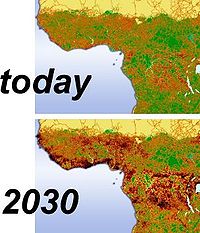
Photo from wikipedia
Abstract Individual size is a major determinant of mobile organisms’ ecology and behavior. This study aims to explore whether allometric scaling principles can provide an underlying framework for general patterns… Click to show full abstract
Abstract Individual size is a major determinant of mobile organisms’ ecology and behavior. This study aims to explore whether allometric scaling principles can provide an underlying framework for general patterns of resource patch use. To this end, we used giving‐up densities (GUDs), that is, the amount of resources remaining in a patch after a forager has quit feeding, as a comparative measure of the amount of resources exploited by a forager of any given size. We specifically tested the hypothesis that size‐dependent responses to both internal (energy requirement) and external (risk management) forces may have an effect on GUDs. We addressed this topic by conducting an extensive meta‐analysis of published data on granivorous rodents, including 292 GUD measurements reported in 25 papers. The data set includes data on 22 granivorous rodent species belonging to three taxonomic suborders (Castorimorpha, Myomorpha, and Sciuromorpha) and spans three habitat types (desert, grassland, and forest). The observations refer to both patches subject to predation risk and safe patches. Pooling all data, we observed positive allometric scaling of GUDs with average forager size (scaling exponent = 0.45), which explained 15% of overall variance in individual GUDs. Perceived predation risk during foraging led to an increase in GUDs independently of forager size and taxonomy and of habitat type, which explained an additional 12% of overall GUD variance. The size scaling exponent of GUDs is positive across habitat types and taxonomic suborders of rodents. Some variation was observed, however. The scaling coefficients in grassland and forest habitat types were significantly higher than in the desert habitat type. In addition, Sciuromorpha and Myomorpha exhibited a more pronounced size scaling of GUDs than Castorimorpha. This suggests that different adaptive behaviors may be used in different contexts and/or from different foragers. With body size being a fundamental ecological descriptor, research into size scaling of GUDs may help to place patch‐use observations in a broader allometric framework.
Journal Title: Ecology
Year Published: 2019
Link to full text (if available)
Share on Social Media: Sign Up to like & get
recommendations!